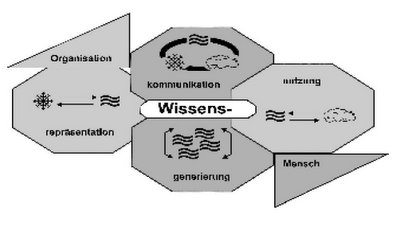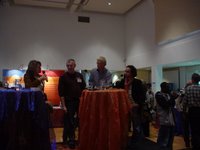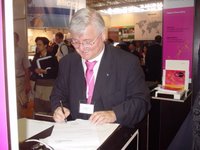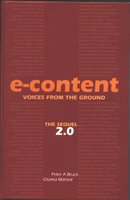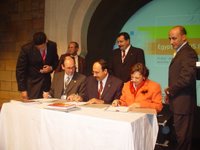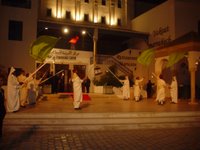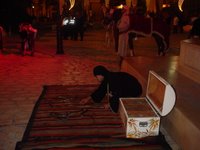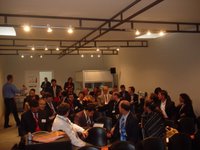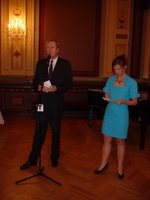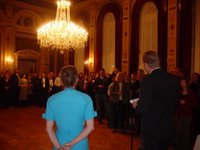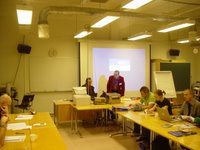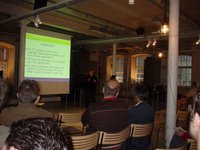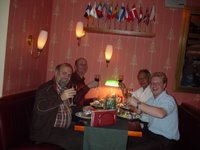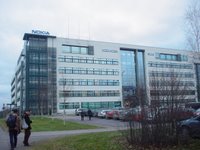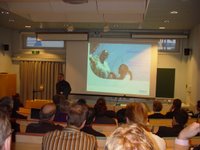 I thought I could close the series on the WSIS and WSA in Tunis, but I found this press release of the WSIS organiser the International Telecommunications Union (ITU) in my mailbox. It is clear that the ITU has a completely different evaluation of the event. I reproduce the press release without any personal comment.
I thought I could close the series on the WSIS and WSA in Tunis, but I found this press release of the WSIS organiser the International Telecommunications Union (ITU) in my mailbox. It is clear that the ITU has a completely different evaluation of the event. I reproduce the press release without any personal comment.WORLD SUMMIT HAILED AS RESOUNDING SUCCESS; CONSENSUS, COMMITMENT
PAVE WAY TO MORE EQUITABLE INFORMATION SOCIETY
The second phase of the World Summit on the Information Society (WSIS) closed after almost a week of intense negotiations, eight plenary sessions, 308 parallel events organized by 264 organizations and 33 press conferences attracting around 19,000 participants worldwide.
Hailed as a resounding success by national delegations from 174 States and participants from more than 800 entities including United Nations agencies, private sector companies and civil society organizations, the Summit was convened in Tunis to tackle the problem of the "digital divide" and harness the potential of information and communication technology (ICT) to drive economic and social development.
The two Summit outcome documents -- the Tunis Commitment and the Tunis Agenda for the Information Society -- were endorsed by world leaders at the closing plenary of the Summit on Friday evening.
Addressing delegates at the eighth and final Plenary session, Yoshio Utsumi, Secretary-General of the Summit, said it had been a long road and seven years since the idea for the Summit was first adopted by the International Telecommunication Union (ITU) Minneapolis Plenipotentiary Conference. "It is fitting that this stage of our journey ends here in Tunis, the capital of the country that launched the process", said Mr. Utsumi. "Uniquely, WSIS was a Summit held in two phases. Through this approach, WSIS took place in one developed and one developing country. This helped ensure that the full range of issues of the Information Society were addressed, while highlighting the critical need to bridge the digital divide."
He added that the two-phase process has enabled the development of a concrete plan for implementation at the national, regional and international levels, which will ensure commitments that have been undertaken are fulfilled. "In a very real sense, WSIS is about making the best use of a new opportunity and a new tool. WSIS reinforces the value of global dialogue and cooperation to address emerging issues in the twenty-first century. The Information Society can be a win-win situation for all, provided that we take the right actions."
Worldwide Commitment
19,401 participants took part in the Summit, including:
-- 46 Heads of State and Government, Crown Princes and Vice-Presidents and 197 Ministers/Vice-Ministers and Deputy Ministers;
-- 5,857 participants representing 174 States and the European Community;
-- 1,508 participants representing 92 international organizations;
-- 6,241 participants representing 606 non-governmental organizations
(NGOs) and civil society entities;
-- 4,816 participants representing 226 business sector entities; and
-- 1,222 accredited journalists from 642 media organizations of which 979 on site from TV, radio, print and online media worldwide.
Global Agreement on Crucial Issues
Three key issues dominated the preparatory process leading to the Tunis Summit: Internet governance, financing strategies, and implementation mechanisms for the Action Plan developed by the first phase of the WSIS in 2003, in Geneva.
Internet Governance
The breakthrough agreement on Internet governance brokered in Tunis acknowledges the need for enhanced cooperation to enable Governments and is based around a number of newly agreed principles and future mechanisms:
-- all Governments should play an equal role and have equal responsibility for Internet governance while ensuring its continuing stability, security and continuity;
-- nations should not be involved in decisions regarding another nation's country code top level domain (ccTLD); and
-- there is a need for strengthened cooperation among stakeholder for public policies for generic top level domain names (gTLDs).
This cooperation should include the development of globally applicable principles on public policy issues associated with the coordination and management of critical Internet resources. The process of moving towards such enhanced cooperation will be initiated by the end of Q1 2006.
Another important element of the Tunis output document is the creation of a new Internet Governance Forum (IGF), to be convened by the UN Secretary-General, to foster and enable multi-stakeholder dialogue on public policy and development issues. This Forum will provide a platform for discussion of cross-cutting public policy issues not adequately addressed by current mechanisms. The new Forum is expected to be established in the first half of 2006, with an inaugural meeting to be hosted in Athens at the invitation of the Government of Greece.
The IGF will facilitate the exchange of information and best practices, and help find solutions to issues of concern to everyday users arising from the use and misuse of the Internet, identify emerging issues and bring them to the attention of relevant decision-making bodies, and where appropriate, make recommendations. The forum will draw upon resources from all interested stakeholders, including the proven expertise of the ITU.
The IGF will have no oversight function and will not replace existing arrangements, mechanisms, institutions or organizations. It will have no involvement in the day-to-day running and technical operation of the Internet.
The principles and elements agreed at Tunis mark the turning of a new page in the ongoing internationalization of Internet governance. In the coming years, the continued reinforcement of regional and national Internet resource management will guarantee the national interests and rights of countries in managing their own Internet resources, while at the same time maintaining global coordination.
Financing Mechanisms
The WSIS outcome texts reaffirm the Geneva agreements that information and communication technologies are a key tool in national development strategies. For that reason, financing of ICT deployment is vital to meeting the Millennium Development Goals.
The document welcomes the creation of the Digital Solidarity Fund. It underlines the importance of providing quality, affordable communication access to all citizens, and notes the inequalities that presently exist.
It also identifies areas where existing financing mechanisms could be improved, and where ICT could be given a higher priority by both developing countries and their development partners, based on such existing financial commitments such as the Monterrey Consensus. While it is recognized that financing of ICT infrastructure cannot solely be based on public investment, it is also recognized that private investment and market forces alone cannot guarantee the full participation of developing countries in the global market for ICT services. Strengthened cooperation and solidarity is therefore encouraged, along with national development policies that support an enabling and competitive environment.
Way Forward: Follow-Up and Implementation
Tunis is not the end of the road for the WSIS. As the Summit of Solutions, the Tunis Agenda for the Information Society recognizes that it is now time to turn principles into actions.
Although more than 2,500 projects were undertaken to bridge the digital divide between the first and second phases of the WSIS, the Tunis output documents clearly emphasize that more needs to be done, and done quickly. Already, the ITU is managing the WSIS stocktaking process to create a database of ICT implementation activities. For the Tunis phase of the Summit, it also created a so-called Golden Book listing projects announced during the Summit. More than 200 projects have been included to date, many of which are multimillion dollar undertakings.
The 11 Action Lines in the original Geneva Action Plan set forth key elements in the building of the Information Society. The Tunis Agenda now establishes a specific list of possible moderators/facilitators for each of these Action Lines.
In the coming months, major efforts will be undertaken to organize the implementation of the Geneva and Tunis resolutions.
To coordinate this work -- and as requested in the Tunis Agenda -- Secretary-General Utsumi announced that the ITU will soon convene a meeting of Action Line moderators. This meeting will be organized in collaboration with UNESCO (United Nations Educational, Scientific and Cultural Organization) and UNDP (United Nations Development Programme), who, together, represent the three key pillars of the Information Society: infrastructure, content and development.
Work to implement the Action Lines will be complemented by ongoing ITU stocktaking work and on finalization of an agreed methodology for evaluation of progress in bridging the digital divide based on a common set of core indicators as well as the use of composite indices.
To facilitate the implementation of the WSIS outcomes, the Secretary-General of the United Nations is also asked to consult the Chief Executive Board (CEB), which consists of the heads of major UN agencies and meets biannually, to establish a UN Group on the Information Society. Over the coming months, a plan will be developed for the creation, functioning, objectives and work methods of this Group. This Plan will be presented to the next CEB meeting in Madrid in April 2006. The ITU, UNESCO and the UNDP are all expected to play a lead role in the creation of this Group.
In addition, through ECOSOC the UN Secretary-General will report to the General Assembly by June 2006 on the modalities of interagency coordination of implementation. At the same meeting, Yoshio Utsumi, as Secretary-General of the Summit, will also report on the outcomes.
In November 2006, the ITU will hold its Plenipotentiary Conference in Antalya, Turkey and on that occasion will continue to adapt its mandate to the demands of the Information Society.
Dialogue Continues
The world of ICT is characterized by fast-paced and non-stop technological change. The Internet of tomorrow will look very different from the Internet of today, as revealed in the ITU's new report, The Internet of Things, which was released at the Tunis summit.
The follow-up process established by the WSIS contains several built-in milestones to ensure that policy review and debate continue, so that the outcomes of the Summit can be shaped to changes in the world of ICT.
At the national level, all countries are called upon to develop national e-strategies as an integral part of national development plans and poverty reduction strategies. The deadline for this action is 2015, but many countries have already begun to implement such plans.
Affordability of access is a critical part of bridging the digital divide. As tasked by the Summit, the ITU will continue its efforts to study the question of international Internet connectivity as a matter of urgency.
The Tunis Agenda calls on ECOSOC to oversee the system-wide follow-up of the Tunis and Geneva outcomes. Consistent with the reform of ECOSOC requested by world leaders at the Summit in September in New York, the Tunis output calls on ECOSOC to review the mandate of the Commission on Science and Technology for Development, including the multi-stakeholder approach.
These efforts will culminate in an overall review by the General Assembly in 2015 of the implementation of the WSIS outcomes. This is the same deadline established in the Geneva Plan of Action to connect all unconnected communities.
Finally, the UN General Assembly is asked to declare 17 May as World Information Society Day. 17 May has traditionally been celebrated as World Telecommunications Day, so the ITU will collaborate in this process to give even greater magnitude to that event.
Addressing delegates at the closing of the eighth and final plenary session, Mr. Utsumi spoke of his satisfaction that the WSIS process has put ICT at the centre of countries' national development plans. "As a result of this Summit, world leaders are now fully aware of the critical importance of ICTs", he said. In the end, he continued, the WSIS is "not just about technology. It's mostly about people, and their potential."
The full text of the Tunis Commitment can be found at
http://www.itu.int/wsis/docs2/tunis/off/7.htmlThe Tunis Agenda for the Information Society can be found at
http://www.itu.int/wsis/docs2/tunis/off/6rev1.html
 Market shares of the Dutch mobile companies
Market shares of the Dutch mobile companies
